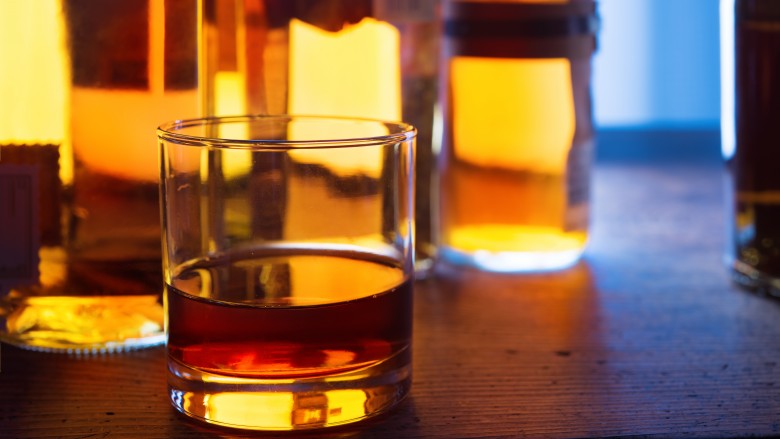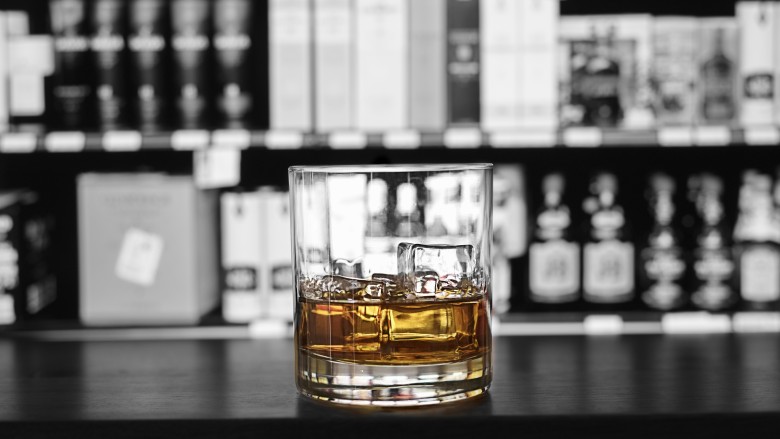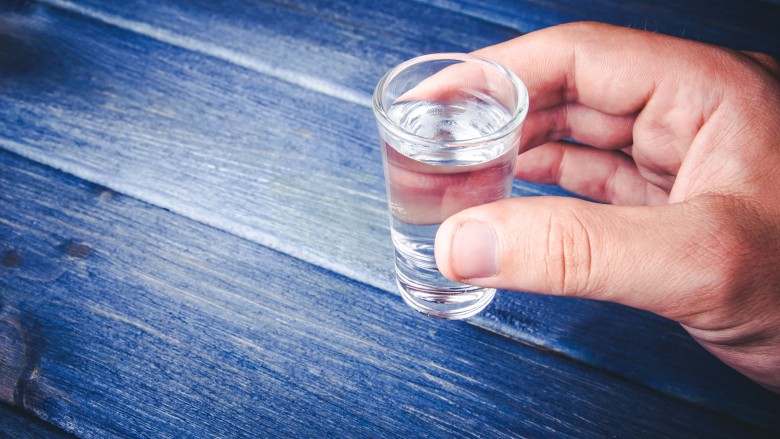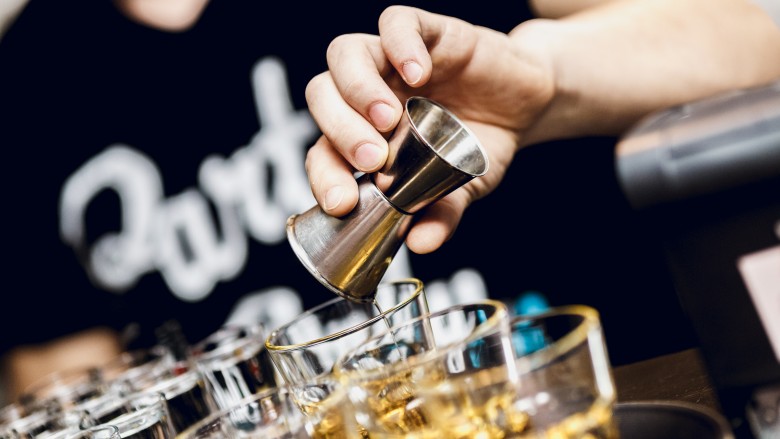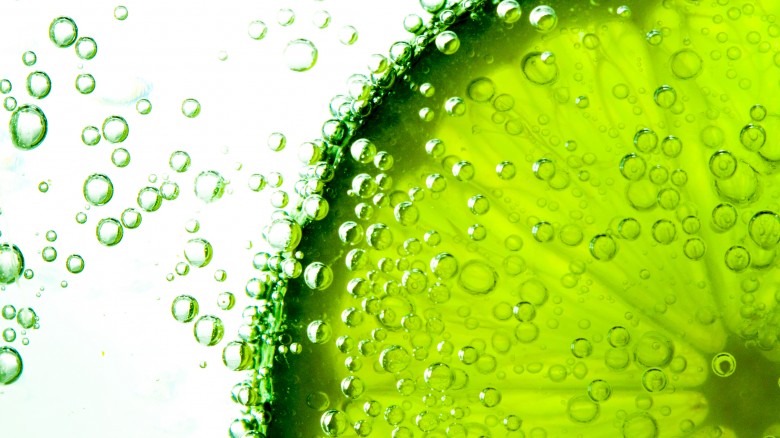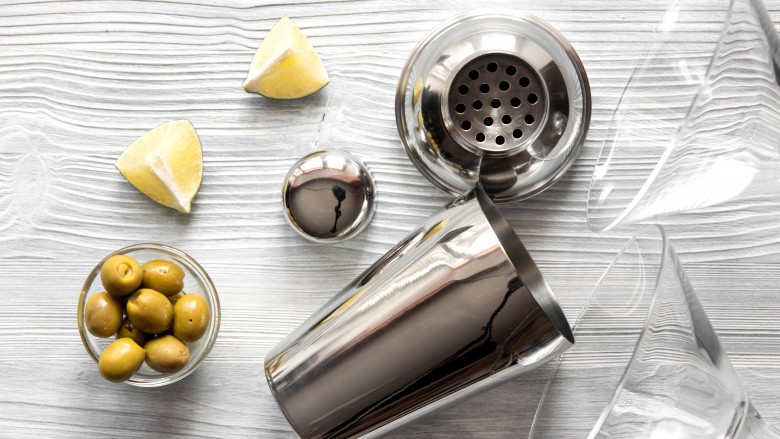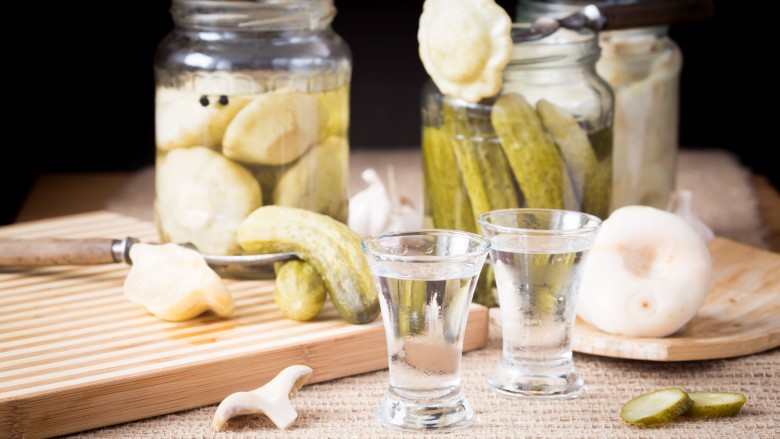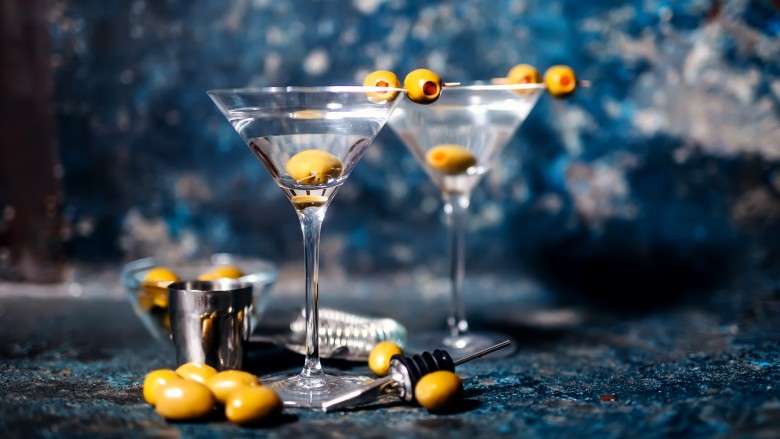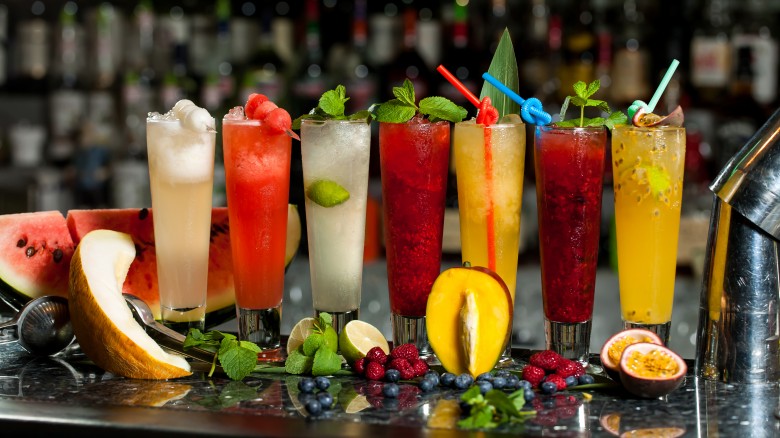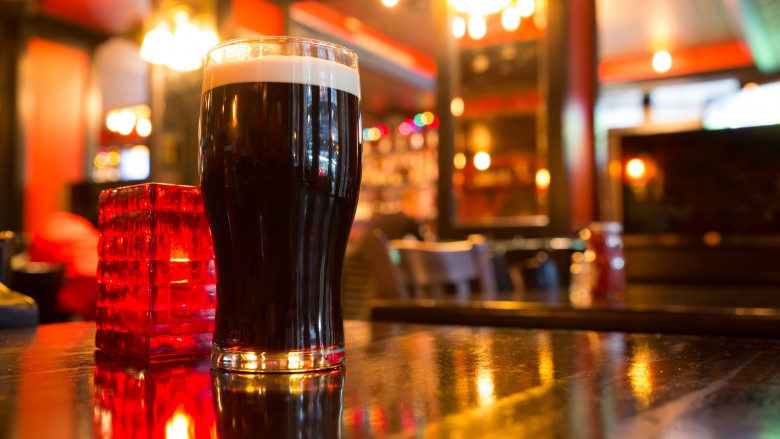Bartending Terms You Should Know
Whether you're heading out for happy hour with coworkers or mixing up some cocktails for a party at home, the quality of your drinks can make or break your entire evening. Knowing just what goes into a drink is just half of it — you also need to know how to communicate exactly what you want to your bartender or host. Using the right terminology guarantees everyone's on the same page, and it'll go a long way toward making sure everyone gets exactly what they want. Here's what you need to know.
The difference between neat, up, and straight up
Straight up is probably the term you hear most often, and it's usually the one that's growled across the bar by the hard-working, down-on-his-luck detective in your favorite crime drama. Even if you know it means he's looking for a glass with nothing but alcohol in it, you're only most of the way there. Most of the time, bartenders will understand "straight up" to mean you just want them to pour the alcohol in a glass and be done with it, but if you're also ordering something that's as good at room temperature as it is chilled, your straightforward, "straight up" order might actually need some clarification, as there's nothing in the definition that includes temperature.
And that brings you to "neat," a term you might not hear tossed around nearly as much. Neat means much the same as what we think straight up means: pour it out of the bottle and into the glass. There's no chilling, no ice, and definitely no mixers, and it only applies to a drink that's purely one kind of alcohol.
So, what about asking for something just "up"? That's what you use if you're looking for a drink that's chilled, but without the ice in your glass. Got that straight?
On the rocks, frosted, or mist?
You've probably heard the term "on the rocks" before, too, and you probably even know that means that you'd like your drink served over ice. You can certainly ask for any liquor that way, but there are a few reasons some drink orders might get you a strange look. Whiskey is the one that's most commonly ordered on the rocks, and that's because whiskey and ice act together to give you the best and biggest experience when it comes to flavor and aroma. Some particularly high-alcohol whiskey and bourbon brands need the ice to tone them down a bit, but the down side is that it can dilute your drink if you take too long.
On the other hand, while some blended scotch brands are perfectly fine on the rocks, if you order a high-end scotch that way, you might get the same sort of reaction as you would if you tried to pay for it with your first-born. That brings you to one of those other terms, and that's "frosted." If you want some high-end scotch chilled, it's more proper to chill the glass first. Take it one step further, and you might find yourself asking for a frosted glass. That's a glass that's been dipped in water and frozen in preparation for serving your drink and strangely, the most common time to see a frosted glass is the completely wrong one. While it's become trendy to serve beer in a frosted glass, it's actually taking away from most of the flavor.
"Mist" brings you back to your scotch order. If you want something served over ice chips or crushed ice instead of ice cubes, ask for a mist to get all the chill and just the right amount of dilution.
Fingers for measurement
If you've ever heard anyone ask for two fingers of whiskey and found yourself thinking it sounds like they should be asking for, "two fingers of your finest sippin' whiskey, ma'am", like they're an olde-timey gunslinger, you're not wrong. The term comes from the saloons of the Old West, and it's a measure defined by the width of the barman's fingers. Since everyone has hands and fingers that are different sizes, that obviously can mean very different things depending on who you're ordering your drink from.
Most of the ways of the Old West have disappeared, and this is partially on its way out, too. While you might still order by the finger or two, it's slowly become more accepted to consider a finger as three quarters of an ounce. That makes quite a bit less than a shot, which is typically either 1.25 or 1.5 ounces, depending on the bar's practices. If you want the equivalent of a shot, you can order two fingers and be not too far off, but still a bit archaic.
Shots: A jigger, a splash, a nip, and a pony
Whether you're ordering a shot on its own or mixing a drink, you might hear some terms tossed around in the context of a shot. It turns out that measuring shots — and the liquor for your cocktail — is a bit more complicated than just asking for a shot of something.
If you hear the term "jigger," they're probably referring to those hourglass-shaped measuring cups you might see your bartender using. Jiggers come in all different sizes that range from half an ounce up to two ounces. The most common measurement jiggers are used for is also called a jigger, just to make things more confusing: it's the term for an ounce and a half of liquor. Another term you might hear tossed about it the pony shot, and that's a relatively small shot of one ounce. A nip, on the other hand, goes the other way: that's two ounces. If you ask for a splash of a particular something, you're actually asking for a specific measurement: an eighth of an ounce.
Jiggers have become more and more common, and they're not just tools for bartenders who are new any more. There's a massive benefit to using them, and that's to make sure each and every drink is made exactly the same way no matter how many your bartender goes through, or even who is making it. Sure, the count method is great for some, but if you want something precise, measure!
The difference between the fizzy waters
There are a ton of fizzy waters out there, and you might not have even considered whether or not there's a difference between tonic water, club soda, carbonated water, seltzer, and mineral water. Surely, there must be a reason there are so many different names for water, right?
There are some minor differences, and they're good to keep in mind if you're ordering a drink at the bar and getting specific about just what you want included in it. Tonic is perhaps the most specific sort of fizzy water, and the thing that makes it the only fizzy water for a gin and tonic is something called quinine. If you're looking for a bit of fun bar trivia, water laced with ground cinchona tree bark — and quinine — was once thought to protect British troops in India from malaria. It was incredibly bitter, though, and they added some soda water and ultimately gin to create the drink that's much more than medicinal today.
Now, for the other terms. While carbonated water can refer to any fizzy water, mineral water is more specifically water that contains at least 250 parts per million of natural, dissolved minerals, and it's generally not used as a mixer in drinks. Seltzer is plain old water that's carbonated, and club soda is halfway between seltzer and mineral water. While club soda generally contains minerals, they're added artificially. That makes it cheaper than mineral water, and it has less of a heavy mineral taste. If you're looking for a fizzy water to use as a mixer with something other than gin, that's either club soda or seltzer.
Why you need to know the difference between shaken and stirred
The difference between shaking and stirring a cocktail might seem pretty obvious, but there is actually some pretty neat science that's happening when you choose one over the other. At the heart of the process is the same thing. By doing either, you're changing the drink in two ways: you're diluting it, and you're chilling it. How much dilution and how much chill you want dictates which method you use.
When you shake a drink, you're aerating it at the same time you're cooling it (and it takes about 15 seconds for the ice and your drink to come to the same temperature). If you're wondering what aerating actually does, it's changing the texture of your drink to make it slightly fizzy and filled with ice shards small enough to sneak through the straining process — making it cooler and more diluted faster.
On the other hand, stirring your drink is going to cool it slower, and it's also going to get less diluted. Generally, the size and shape of the ice cubes you use for shaking don't matter, but if you want something stirred, those ice cubes matter a lot. Use a single, huge cube, and your drink will be less diluted but not as cold. Use smaller ice cubes, and you're increasing both the chill factor and the dilution. It's science at its finest!
Do you order a back or a chaser?
Ordering either a back or a chaser is going to get you a second glass (or bite) of something non-alcoholic, and the distinction is what you do with it after you're served. If you want something to sip alongside your alcoholic drink — like a glass of cola to drink alongside your whiskey — that's called a back. If you want something to drink after you've slammed a shot, that's a chaser.
One of the most popular new chasers also seems like it's the most unlikely, and that's pickle juice. Bartending lore says the idea of the pickleback — that's a shot of whiskey with a pickle juice chaser — was invented in 2006, but pickle juice has been paired with tequila for much, much longer than that. There's some science at work here, too, and it involves the ability of salt brine to mask certain flavors that might make straight liquor too overpowering. Don't knock it until you've tried it!
Martini terms
If you've ever decided not to order a martini because you're not entirely sure what all the descriptors mean, you're certainly not alone. Once you've decided between shaken and stirred, there are a whole bunch of other things you have to decide on, so let's clear them up a bit.
Vermouth is one of the martini's key ingredients, and it can be described as a bitter, botanical wine. Martinis call for dry vermouth, and it's when you order a dry martini that there's usually a lot of confusion. In this case, dry refers to the amount of vermouth you want in your drink, so think of it this way: if something's dry, it has little water. In a dry martini, you want a little dry vermouth. On the other hand, if something's wet, it has a lot of water. That means that a wet martini has a lot of dry vermouth. It seems backwards, right? If you happen to forget, you can always ask for a perfect martini, and that's going to have equal measures of ingredients.
Olives aren't for everyone, and if you're not a fan, that doesn't need to keep you away from martinis. Just order it "with a twist", and you'll get a piece of lemon peel instead of olives. There are a couple other terms for differentiating your martinis, too. If you ask for a "Gibson," you'll get a pearl onion instead of lemon peel or olives, and if you ask for a dirty martini, that's going to come with a splash of olive juice. And, if you want to get authentically James Bond, order a "vesper." That's going to come with vodka, gin, and an aperitif wine, and the way to remember this one is that the extra alcohol might have you praying the next morning.
What's the difference between a cocktail and a mixed drink?
If you've ever wondered whether or not you're using the terms "cocktail" and "mixed drink" correctly, this one actually involves a fascinating bit of linguistic history. Today, official definitions suggest they're pretty much the same, and if you're looking to order a bit of liquor mixed with or flavored with other ingredients, you're perfectly right if you use either term. That wasn't always the case, though, and it wasn't long ago that "cocktail" meant something more specific: a mix of spirits, bitters, sugar, and water. That's it, and those are still the basic ingredients in some of the most "perfect" cocktails.
The stories about where the term came from are fascinating, but at the end, they can be summed up by a resounding, "We don't know." Some theories involve the idea that the dregs of a cask were mixed with other ingredients to make them more palatable, and those dregs were called cock tailings. It's also been suggested that they're called cocktails because they originally used liquor distilled from mash made from chicken food, while another says that the word was adapted from the name of an Aztec goddess.
One of the most likely stories involves the actual, historical people consulted for James Fenimore Cooper's The Spy: A Tale of Neutral Ground. He's one of the ones credited with coining the term (he gives the invention to one of his characters), but research seems to suggest it came from interviews with the very real people he based his characters on. The long story short is that today, you can use either and you won't be wrong.
International variances
Head overseas and you're likely to find yourself needing to learn all your familiar bartending terms all over again. It's important to note that some familiar terms might even mean something different if you find yourself, say, sitting in a pub in England. There, ordering a pony is going to get you a half-shot, for example, while a jigger is a standard shot... give or take.
There, you might find yourself ordering a noggin or a gill, and sometimes, you might even order a yard. While the basics translate, you're not going to go wrong to do your research before you head off on vacation to make sure you're at home at the bar no matter where in the world you are. Your bartender will thank you for it.

